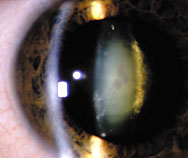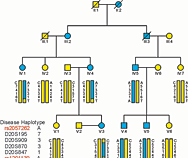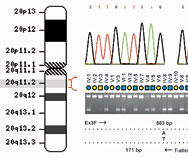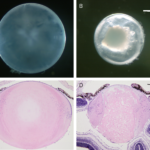Shiels Lab
Alan Shiels PhD, Professor, Ophthalmology & Visual Sciences, and Genetics
Research Overview
Our research focuses on the molecular genetic mechanisms underlying lens development and cataract(s). Despite surgical treatment, age-related forms of cataract remain a leading cause of low vision and blindness worldwide. Using genome-wide mapping and targeted/exome sequencing techniques we have discovered several genes underlying inherited forms of early-onset (pediatric) cataract and other associated ocular or systemic disorders in humans (Table 1). Genes underlying relatively rare forms of inherited cataract have also been associated with much more common forms of age-related cataract – providing molecular genetic links between lens development and aging. Currently, we are characterizing several strains of mutant mice in order to model the pathogenic mechanisms underlying cataract development in humans (Table 2). Results from these studies will advance understanding of lens and anterior eye development in health versus disease and contribute to the discovery of therapeutic targets for cataract.
Molecular Genetic Mechanisms underlying Lens Development and Cataract
Biomedical context: The crystalline lens is critical for anterior eye development and refractive vision in vertebrates. Loss of lens transparency or cataract(s) is frequently acquired with aging and, despite surgical treatment, age-related cataract remains a leading cause of visual impairment (low vision and blindness) worldwide. Cataract may also be inherited as a classical Mendelian trait that usually presents with an early-onset (pediatric). Congenital and infantile forms of cataract pose a clinically important cause of deprivation amblyopia (eye wandering), nystagmus (eye oscillation), and strabismus (eye misalignment) and, further, risk post-surgical complications (e.g., glaucoma) and life-long visual impairment. Approximately 200 causative genes have been found for inherited forms of cataract – with or without other ocular and/or systemic abnormalities (https://cat-map.wustl.edu). Curiously, genes underlying rare forms of inherited cataract are emerging as susceptibility genes for common forms of age-related cataract – supporting molecular genetic links between lens development and lens aging. In previous human genetic studies, we have discovered mutations and/or variants in several genes underlying inherited or age-related forms of cataract. Based on these findings, we are engaged in three interdisciplinary projects focused on cell-membrane proteins using state-of-the-art molecular genetics and cellular imaging techniques to model cataract gene function and dysfunction in mice.
1. TRPM3 project: TRPM3 belongs to the melastatin sub-family of the transient receptor potential (TRP) superfamily of cation channels that serve as polymodal cellular sensors in critical physiological processes across the animal kingdom including the perception of light, temperature, pressure, and pain. We have shown that mutation of the human TRPM3 gene underlies an inherited form of pediatric cataract with or without glaucoma and anterior eye defects. The overall goal of this project is to determine the role of TRPM3 in development and aging of the lens and other eye tissues – with particular focus on calcium dynamics/signaling.
2. EPHA2 project: EPHA2 belongs to the ephrin receptor sub-family of mammalian receptor tyrosine kinases that elicit diverse signaling pathways in embryonic development, adult tissue homeostasis, and various diseases including cancer. We have shown that mutation of the human EPHA2 gene underlies inherited cataract, whereas, EPHA2 variants are associated with age-related cataract. The overall goal of this project is to determine the role of EPHA2 signaling in lens development and aging – with particular focus on cell pattern-formation/recognition.
3. CHMP4B project: CHMP4B is a core subunit of the phylogenetically conserved (yeast-to-human) endosome sorting complex required for transport-III (ESCRT-III) machinery that facilitates diverse eukaryotic membrane remodeling and scission processes including viral budding, cytokinesis, and membrane repair. We have shown that mutations in the human CHMP4B gene underlie inherited forms of ‘posterior polar’ cataract. The overall goal of this study is to elucidate the role of CHMP4B complexes in lens cell membrane differentiation and function – with particular focus on cell-cell communication.


- Genetic mapping and sequencing studies (phenotype-to-genotype): We have used genome-wide mapping (e.g., SNP markers) and targeted sequencing (e.g., exome) approaches in order to discover causative genes underlying inherited forms of pediatric cataract segregating in families (Table 1). Beyond the predicted genes for cataract, such as those for lens crystallins (CRY) and gap-junction/connexin proteins (GJA3/8), we have discovered several novel genes for cataract including CHMP4B, EPHA2, and TRPM3 (Table 1). We have also identified several germ-line variants and potential somatic variants in EPHA2 that are associated with susceptibility to age-related cataract. Click on the Cat-Map link to view other genes associated with cataract.
In addition to cataract, we have identified mutations in FRMD7 and EFEMP1 underlying an X-linked form of ideopathic infantile nystagmus and autosomal dominant form of open-angle glaucoma, respectively.
Table 1. Genes underlying inherited cataract and associated ocular or systemic disease discovered in the Shiels lab
| Cytogenetic location (Physical co-ordinates) | Gene symbol | Exon | DNA change | Protein change | Ocular/systemic phenotype |
| 1p36.13 (16124337..16156104, complement) | EPHA2 | Ex17 | c.2842G>T | p.G948W | Posterior polar cataract |
| 1q21.2 (147902795..147915287) | GJA8 | Ex2 Ex2 | c.142G>A c.262C>T | p.E48K p.P88S | Zonular nuclear pulverulent cataract Zonular pulverulent cataract |
| 2q33.3 (208121607-208124524, complement) | CRYGD | Ex2 | c.70C>A | p.P24T | Coral-like cataract |
| 2p16.1 (55865967..55924163, complement) | EFEMP1 | Ex5 | c.418C>T | p.R140W | Primary open angle glaucoma |
| 9q21.12-q21.13 (70529060-71446971, complement) | TRPM3 | Ex4 | c.195A>G | p.I65M | Polymorphic cataract ± glaucoma and/or anterior eye defects |
| 13q12.11 (20138252-20161327, complement) | GJA3 | Ex2 Ex2 Ex2 | c.176C>T c.188A>G c.1137insC | p.P59L p.N63S p.S380fsX87 | Nuclear punctate cataract Variable pulverulent cataract Punctate cataract |
| 19q13.33 (48963941..48966879) | FTL-IRE | 5′- IRE | c.-168G>T | n/a | Hereditary hyperferritinemia-cataract syndrome |
| 20q11.22 (33811348-33854366) | CHMP4B | 3 3 | c.386A>T c.481G>A | p.D129V p.E161K | Posterior sub-capsular cataract Posterior polar cataract |
| 21q22.23 (43169008-43172810) | CRYAA | 1 | c.145C>T | p.R49C | Central nuclear cataract |
| 22q12.1 (26599278-26618104, complement) | CRYBB1 | 6 | c.728G>T | p.G220X | Central sutural pulverulent cataract |
| Xq26.2 (132074926..132128022, complement) | FRMD7 | 6 | c.425T>G | p.L142R | X-linked idiopathic infantile nystagmus |
- Functional expression studies (genotype-to-phenotype). Currently, we are using several strains of cataract mice that inherit spontaneous or targeted mutations in the genes for (a) an aquaporin water-channel, (b) a cell-junction protein, (c) a chromatin-modifying protein, (d) an ephrin receptor, and (e) a cation channel to elucidate pathogenic mechanisms underlying the development of cataract and certain anterior eye disorders in humans (Table 2). Click on the Cat-Map link to view other mouse models of human cataract.
Table 2. Mouse models of human cataract under investigation in the Shiels lab.
| Cytogenetic location (Physical co-ordinates) | Gene | Mutant allele | Exon/ Intron | DNA change | Protein change | Lens Phenotype |
| 3 F1; 3 39.04 cM (89271730..89280951, complement) | Efna1 | tm1Jch | Ex1 | null | null | Like wild-type |
| 4 D3; 4 73.67 cM (141301221..141329384) | Epha2 | tm1Jrui (neo) | Ex5 | null | null | Refractive disturbance, cell patterning defects |
| 7 B3; 7 28.25 cM (43430099..43435996) | Lim2 | Gt(VICTR48)Lex | IVS3 | null | null | Refractive defects and pulverulent opacities |
| 10 D3; 10 76.49 cM (128225810..128231812) | Mip/ Aqp0 | Catlop | Ex1 | c.151G>C | p.A51P | Dense central opacity, microphakia |
| 10 D3; 10 76.49 cM (128225810..128231812) | Mip/ Aqp0 | Gt(VICTR20)8Lex | Ex1 | null | null | Polymorphic opacities |
| 10 D3; 10 76.49 cM (128225810..128231812) | Mip/ Aqp0 | CatFr | IVS3 | c.607-789delLTR | p.203-263delLTRX59 | Shrivelled, microphakia |
| 17 E1.1; 17 32.57 cM (62602957..62881317, complement) | Efna5 | tm1Ddmo | Ex | null | null | Refractive disturbance, cell patterning defects |
| 19; 19 B (22137797..22995410) | Trpm3 | tm1Ash | Ex4 | c.T>G | Missense, extension | Anterior polar cataract |
| 19; 19 B (22137797..22995410) | tm1Lex/Ori, LEXKO-380 | Ex21-IVS21 | null | null | Impaired growth |
CATMAP
Cat-Map is an online chromosome map and reference database for inherited and age-related forms of cataract(s) in humans, mice, and other vertebrates maintained by the Shiels lab.
Shiels A, Bennett TM, and Hejtmancik JF. Cat-Map: Putting cataract on the map. Mol Vis (2010)
Publications
View all Alan Shiels NCBI publications on PubMed»
Selected Publications
Shiels A. TRPM3_miR-204 – a complex locus for eye development and disease (Review). Hum Genomics 2020; 14:7
Shiels A, Hejtmancik, JF. Biology of inherited cataracts and opportunities for treatment. Ann Rev Vis Sci 2019; 5: 123-149.
Zhou Y, Bennett TM, Shiels A. A charged multivesicular body protein (CHMP4B) is required for lens growth and differentiation. Differentiation 2019; 109:16-27.
Zhou Y, Shiels A. Epha2 and Efna5 participate in lens cell pattern-formation. Differentiation 2018; 102:1-9.
Shiels A, Hejtmancik JF. Mutations and mechanisms in congenital and age-related cataracts. Exp Eye Res 2017; 156:95-102.
Bennett TM, M’Hamdi O, Hejtmancik JF, Shiels A. Germ-line and somatic EPHA2 coding variants in lens aging and cataract. PLoS One 2017; 12(12):e0189881
Bennett TM, Mackay DS, Siegfried CJ, Shiels A. Mutation of the melastatin-related cation channel, TRPM3, underlies inherited cataract and glaucoma. PLoS One 2014; 9(8):e104000.
Shi Y, De Maria A, Bennett TM, Shiels A, Bassnett S. A role for Epha2 in cell migration and refractive organization of the ocular lens. Invest Ophthalmol Vis Sci 2012; 53:551-559.
Shiels A, Bennett TM, Hejtmancik JF. Cat-Map: putting cataract on the map. Mol Vis 2010; 16:2007-2015. (http://cat-map.wustl.edu)
Shiels A, Bennett TM, Knopf HLS, Maraini G, Li A, Jiao X, Hejtmancik JF. The EPHA2 gene is associated with cataracts linked to chromosome 1p. Mol Vis 2008; 14:2042-2055.
Shiels A, Bennett TM, Knopf HLS, Yamada K, Koh-ichiro Y, Niikawa N, Shim S, Hanson PI. CHMP4B, a novel gene for autosomal dominant cataracts linked to chromosome 20q. Am J Hum Genet 2007; 81:596-606.

